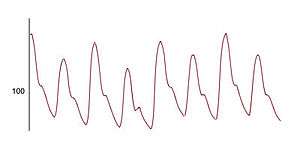Pulsus alternans
| Pulsus alternans | |
|---|---|
 | |
| Pulse pressure waveform displaying the variation in pressure between beats in pulsus alternans. | |
| Classification and external resources | |
| DiseasesDB | 11040 |
Pulsus alternans is a physical finding with arterial pulse waveform showing alternating strong and weak beats.[1] It is almost always indicative of left ventricular systolic impairment, and carries a poor prognosis.
Pathophysiology
In left ventricular dysfunction, the ejection fraction will decrease significantly, causing reduction in stroke volume, hence causing an increase in end-diastolic volume. There may initially be a tachycardia as a compensatory mechanism to try to keep the cardiac output constant. As a result, during the next cycle of systolic phase, the myocardial muscle will be stretched more than usual and as a result there will be an increase in myocardial contraction, related to the Frank–Starling physiology of the heart. This results, in turn, in a stronger systolic pulse .
Physical examination

Palpate radial or femoral arteries, feel for regular rhythm but alternating strong and weak pulses Use blood pressure cuff to confirm: Raise blood pressure cuff to over systolic level then, lower slowly towards the systolic level, if hearing alternating loud & soft korotkoff sounds, pulses alternans is indicated.[2]
Clinical significance
Indicative of severe Left-sided heart failure [3]
In literature
| Wikisource has original text related to this article: |
D.H. Lawrence elegantly describes pulsus alternans in his novel Sons and Lovers:
Then he felt her pulse. There was a strong stroke and a weak one, like a sound and its echo. That was supposed to betoken the end....